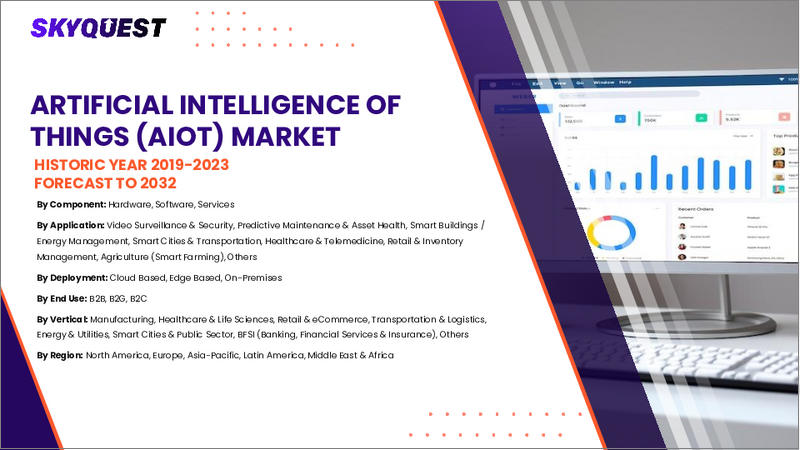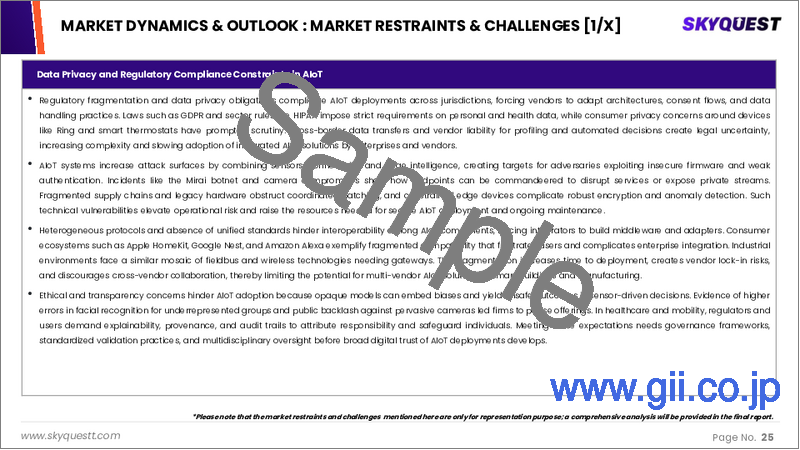|
|
市場調査レポート
商品コード
1796617
モノの人工知能(AIoT)市場規模、シェア、成長分析、コンポーネント別、用途別、最終用途別、地域別 - 産業予測、2025年~2032年Artificial Intelligence of Things (AIoT) Market Size, Share, and Growth Analysis, By Component (Hardware, Software), By Application (Video Surveillance, Inventory Management), By End Use, By Region - Industry Forecast 2025-2032 |
||||||
|
|||||||
| モノの人工知能(AIoT)市場規模、シェア、成長分析、コンポーネント別、用途別、最終用途別、地域別 - 産業予測、2025年~2032年 |
|
出版日: 2025年08月18日
発行: SkyQuest
ページ情報: 英文 193 Pages
納期: 3~5営業日
|
全表示
- 概要
- 目次
モノの人工知能の世界市場規模は2023年に180億1,000万米ドルと評価され、2024年には227億3,000万米ドル、2032年には1,462億3,000万米ドルに成長し、予測期間(2025-2032年)のCAGRは26.2%で成長する見込みです。
モノの人工知能(AIoT)の世界市場は、製造、ヘルスケア、小売、物流などさまざまな分野でスマートオートメーションへの需要が高まっていることに後押しされています。組織はAIoTを活用し、AIの分析能力とIoTのリアルタイムデータ収集の融合を通じて、業務を最適化し生産性を高めています。このテクノロジーは、予知保全やサプライチェーン管理などの複雑なプロセスを合理化することで、エラーを最小限に抑え、効率を高める。エッジコンピューティングは、データの発生源に近い場所で即時データ処理を可能にすることで、待ち時間を短縮しプライバシーを向上させ、AIoTの導入をさらに加速させる。インテリジェントなAIアルゴリズムが予知保全を強化し、運用の適応性を促進することで、市場は関心と投資の高まりを目の当たりにしており、多様なアプリケーションにおけるAIoTの変革の可能性を実証しています。
目次
イントロダクション
- 調査の目的
- 調査範囲
- 定義
調査手法
- 情報調達
- 二次と一次データの方法
- 市場規模予測
- 市場の前提条件と制限
エグゼクティブサマリー
- 世界市場の見通し
- 供給と需要の動向分析
- セグメント別機会分析
市場力学と見通し
- 市場概要
- 市場規模
- 市場力学
- 促進要因と機会
- 抑制要因と課題
- ポーターの分析
主な市場の考察
- 重要成功要因
- 競合の程度
- 主な投資機会
- 市場エコシステム
- 市場の魅力指数(2024年)
- PESTEL分析
- マクロ経済指標
- バリューチェーン分析
- 価格分析
- 技術分析
- ケーススタディ
- 顧客購買行動分析
世界のモノの人工知能(AI)市場規模:コンポーネント別& CAGR(2025-2032)
- 市場概要
- ハードウェア
- ソフトウェア
- サービス
世界AI市場規模:用途別& CAGR(2025-2032)
- 市場概要
- 資産追跡と管理
- 予知保全
- リアルタイム監視
- セキュリティと監視
- エネルギー管理
- スマート家電
世界のモノの人工知能市場規模:エンドユーザー別& CAGR(2025-2032)
- 市場概要
- スマートホーム
- スマートシティ
- 産業用IoT(IIoT)
- ヘルスケア
- 自動車
- 小売り
- 農業
世界のモノの人工知能市場規模:地域別& CAGR(2025-2032)
- 北米
- 米国
- カナダ
- 欧州
- ドイツ
- スペイン
- フランス
- 英国
- イタリア
- その他欧州地域
- アジア太平洋地域
- 中国
- インド
- 日本
- 韓国
- その他アジア太平洋地域
- ラテンアメリカ
- ブラジル
- その他ラテンアメリカ地域
- 中東・アフリカ
- GCC諸国
- 南アフリカ
- その他中東・アフリカ
競合情報
- 上位5社の比較
- 主要企業の市場ポジショニング(2024年)
- 主な市場企業が採用した戦略
- 最近の市場動向
- 企業の市場シェア分析(2024年)
- 主要企業の企業プロファイル
- 企業の詳細
- 製品ポートフォリオ分析
- 企業のセグメント別シェア分析
- 収益の前年比比較(2022-2024年)
主要企業プロファイル
- Google LLC(United States)
- Microsoft Corporation(United States)
- Amazon Web Services(AWS)(United States)
- IBM Corporation(United States)
- Intel Corporation(United States)
- Cisco Systems, Inc.(United States)
- SAP SE(Germany)
- Bosch.IO GmbH(Germany)
- Siemens AG(Germany)
- Huawei Technologies Co., Ltd.(China)
- Qualcomm Technologies, Inc.(United States)
- NVIDIA Corporation(United States)
- PTC Inc.(United States)
- Hitachi, Ltd.(Japan)
- GE Digital(United States)
結論と提言
Global Artificial Intelligence of Things Market size was valued at USD 18.01 Billion in 2023 poised to grow between USD 22.73 Billion in 2024 to USD 146.23 Billion by 2032, growing at a CAGR of 26.2% in the forecast period (2025-2032).
The Global Artificial Intelligence of Things (AIoT) market is being propelled by the growing demand for smart automation across various sectors including manufacturing, healthcare, retail, and logistics. Organizations are utilizing AIoT to optimize operations and boost productivity through the fusion of AI's analytical capabilities and IoT's real-time data gathering. This technology streamlines complex processes like predictive maintenance and supply chain management, thereby minimizing errors and enhancing efficiency. Edge computing further accelerates AIoT adoption by enabling immediate data processing close to its source, which lowers latency and improves privacy. With intelligent AI algorithms enhancing predictive maintenance and driving operational adaptability, the market is witnessing increased interest and investment, demonstrating the transformative potential of AIoT in diverse applications.
Top-down and bottom-up approaches were used to estimate and validate the size of the Global Artificial Intelligence of Things market and to estimate the size of various other dependent submarkets. The research methodology used to estimate the market size includes the following details: The key players in the market were identified through secondary research, and their market shares in the respective regions were determined through primary and secondary research. This entire procedure includes the study of the annual and financial reports of the top market players and extensive interviews for key insights from industry leaders such as CEOs, VPs, directors, and marketing executives. All percentage shares split, and breakdowns were determined using secondary sources and verified through Primary sources. All possible parameters that affect the markets covered in this research study have been accounted for, viewed in extensive detail, verified through primary research, and analyzed to get the final quantitative and qualitative data.
Global Artificial Intelligence of Things Market Segments Analysis
The global Artificial Intelligence of Things Market is segmented based on component, application, end use, and region. In terms of components, the market is trifurcated into hardware, software, and services. Based on application, the market is grouped into video surveillance, inventory management, predictive maintenance, supply chain management, and others. Based on End Use, the market is segmented into B2B, B2G, and B2C. Based on region, the market is segmented into North America, Europe, Asia-Pacific, Central & South America and the Middle East & Africa.
Driver of the Global Artificial Intelligence of Things Market
One key market driver for the Global Artificial Intelligence of Things (AIoT) market is the increasing demand for intelligent automation across various sectors. As organizations seek to enhance operational efficiency and reduce costs, integrating AI capabilities into IoT devices becomes critical. This convergence allows for real-time data analytics, predictive maintenance, and improved decision-making processes, thereby enabling businesses to respond swiftly to market changes. Additionally, the proliferation of advanced connectivity technologies, such as 5G, further accelerates the adoption of AIoT solutions, as they provide the necessary bandwidth and lower latency required for seamless communication between devices, driving innovation and competitive advantage.
Restraints in the Global Artificial Intelligence of Things Market
One significant market restraint for the Global Artificial Intelligence of Things (AIoT) market is the growing concerns over data privacy and security. As AIoT systems increasingly rely on vast amounts of data collected from various devices, the risk of data breaches and misuse of personal information escalates. Regulatory compliance and the implementation of stringent data protection laws can impose additional burdens on companies, potentially stifling innovation and slowing market growth. Furthermore, heightened consumer awareness regarding data privacy issues may deter some users from adopting AIoT technologies, thereby limiting the overall expansion of the market in various sectors.
Market Trends of the Global Artificial Intelligence of Things Market
The Global Artificial Intelligence of Things (AIoT) market is experiencing a significant trend towards the adoption of Edge AIoT, which facilitates real-time data processing at the device level. This approach minimizes latency and enhances system responsiveness, making it particularly beneficial for industries that rely on immediate decision-making, like autonomous vehicles, industrial automation, and healthcare. The integration of AI at the edge empowers devices to act swiftly on data insights, thereby optimizing safety and operational performance. As demand for faster, more efficient data processing intensifies, Edge AIoT is poised to become a cornerstone of intelligent and connected ecosystems.
Table of Contents
Introduction
- Objectives of the Study
- Scope of the Report
- Definitions
Research Methodology
- Information Procurement
- Secondary & Primary Data Methods
- Market Size Estimation
- Market Assumptions & Limitations
Executive Summary
- Global Market Outlook
- Supply & Demand Trend Analysis
- Segmental Opportunity Analysis
Market Dynamics & Outlook
- Market Overview
- Market Size
- Market Dynamics
- Drivers & Opportunities
- Restraints & Challenges
- Porters Analysis
- Competitive rivalry
- Threat of substitute
- Bargaining power of buyers
- Threat of new entrants
- Bargaining power of suppliers
Key Market Insights
- Key Success Factors
- Degree of Competition
- Top Investment Pockets
- Market Ecosystem
- Market Attractiveness Index, 2024
- PESTEL Analysis
- Macro-Economic Indicators
- Value Chain Analysis
- Pricing Analysis
- Technology Analysis
- Case Studies
- Customer Buying Behavior Analysis
Global Artificial Intelligence of Things Market Size by Component & CAGR (2025-2032)
- Market Overview
- Hardware
- Software
- Services
Global Artificial Intelligence of Things Market Size by Application & CAGR (2025-2032)
- Market Overview
- Asset Tracking & Management
- Predictive Maintenance
- Real-Time Monitoring
- Security & Surveillance
- Energy Management
- Smart Appliances
Global Artificial Intelligence of Things Market Size by End Users & CAGR (2025-2032)
- Market Overview
- Smart Homes
- Smart Cities
- Industrial IoT (IIoT)
- Healthcare
- Automotive
- Retail
- Agriculture
Global Artificial Intelligence of Things Market Size & CAGR (2025-2032)
- North America (Component, Application, End Users)
- US
- Canada
- Europe (Component, Application, End Users)
- Germany
- Spain
- France
- UK
- Italy
- Rest of Europe
- Asia Pacific (Component, Application, End Users)
- China
- India
- Japan
- South Korea
- Rest of Asia-Pacific
- Latin America (Component, Application, End Users)
- Brazil
- Rest of Latin America
- Middle East & Africa (Component, Application, End Users)
- GCC Countries
- South Africa
- Rest of Middle East & Africa
Competitive Intelligence
- Top 5 Player Comparison
- Market Positioning of Key Players, 2024
- Strategies Adopted by Key Market Players
- Recent Developments in the Market
- Company Market Share Analysis, 2024
- Company Profiles of All Key Players
- Company Details
- Product Portfolio Analysis
- Company's Segmental Share Analysis
- Revenue Y-O-Y Comparison (2022-2024)
Key Company Profiles
- Google LLC (United States)
- Company Overview
- Business Segment Overview
- Financial Updates
- Key Developments
- Microsoft Corporation (United States)
- Company Overview
- Business Segment Overview
- Financial Updates
- Key Developments
- Amazon Web Services (AWS) (United States)
- Company Overview
- Business Segment Overview
- Financial Updates
- Key Developments
- IBM Corporation (United States)
- Company Overview
- Business Segment Overview
- Financial Updates
- Key Developments
- Intel Corporation (United States)
- Company Overview
- Business Segment Overview
- Financial Updates
- Key Developments
- Cisco Systems, Inc. (United States)
- Company Overview
- Business Segment Overview
- Financial Updates
- Key Developments
- SAP SE (Germany)
- Company Overview
- Business Segment Overview
- Financial Updates
- Key Developments
- Bosch.IO GmbH (Germany)
- Company Overview
- Business Segment Overview
- Financial Updates
- Key Developments
- Siemens AG (Germany)
- Company Overview
- Business Segment Overview
- Financial Updates
- Key Developments
- Huawei Technologies Co., Ltd. (China)
- Company Overview
- Business Segment Overview
- Financial Updates
- Key Developments
- Qualcomm Technologies, Inc. (United States)
- Company Overview
- Business Segment Overview
- Financial Updates
- Key Developments
- NVIDIA Corporation (United States)
- Company Overview
- Business Segment Overview
- Financial Updates
- Key Developments
- PTC Inc. (United States)
- Company Overview
- Business Segment Overview
- Financial Updates
- Key Developments
- Hitachi, Ltd. (Japan)
- Company Overview
- Business Segment Overview
- Financial Updates
- Key Developments
- GE Digital (United States)
- Company Overview
- Business Segment Overview
- Financial Updates
- Key Developments






